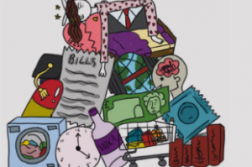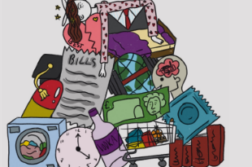This academic year, I started volunteering as a Leader in Training at a local Rainbows unit – the branch of Girl Guiding UK that caters for girls aged 4-7. Once a week, on a Wednesday afternoon, I set aside the dissertation and the JSTOR articles and join in with the girls as they paint, decorate cookies, play playground games, make play-doh and fashion dresses out of bin bags. It soon became clear to me that beyond enjoying getting to know the girls and my lovely fellow Leaders, my mental health was benefitting significantly from taking part in these activities, and reconnecting with my ‘inner child’. Now, 4-7 year olds require a lot of attention – there’s no time to start meal-planning in your head or to worry about your seminar reading: you have to be fully invested in what you’re doing, it’s like mindfulness.
Channelling your inner child is praised by psychologists and wellbeing professionals as a way of improving your mental health and bringing added light and happiness into your life. Play therapy is well-known for the benefits it can bring to children, but it can also be used to help adults as well. This can take the form of playing games or role-playing in group therapy to build communication skills and self-esteem, using art and music therapy, or commonly sand-tray therapy to connect people more strongly to their emotions.
As a child, I remember being drawn to playing in the sandpits at nursery, and it’s no surprise that when adults sit down at a sandpit with their child they often begin to play too – playing with sand is thought to be a powerful therapeutic tool. Founded in the principles of humanistic, mindset and person-centred, psychology, sand-tray therapy can be used to help people work through problems they may be facing in their life. Clients use miniature objects to make changes in the fictional world created in the sand-tray, and then translate these changes and thought patterns to their real-life difficulties. Play therapy can allow clients to visualise their thoughts and feelings in a different way to traditional talking therapies, accessible for those who don’t feel able to articulate how their life experiences have affected them or how they are feeling.
You probably don’t have a sandpit in your student house, as much as that would be a fun talking point for when your landlord drops in. Connecting with your inner child can take lots of forms – it could involve doing some drawing or painting with the focus placed on having fun with it rather than creating a masterpiece, having a game night with your housemates, switching out your regular drink night with friends for going bowling, playing mini-golf, or shuffleboard together. Research shows that play helps you to relieve stress, stimulate creativity, foster a connection with others, improve brain function and boost your energy levels.
Taking time out from your studies is essential for maintaining good mental health that allows you to cope with them, and I’ve found spending just one hour a week taking part in playful activities that require full focus and attention can do wonders. Volunteering with the Rainbows has also given me a sense of connection with the Southampton community, something that can be hard to forge in an unfamiliar university town. When I tell people I help out at Rainbows, they often praise this community spirit or how it will look good on a CV. The real joy, though, comes from listening to the girls’ stories about their days, helping them out with writing, and connecting with my own inner child through painting animals with them (even if they do look at my best attempt and, quite fairly, say “I can’t even tell what that is”).



